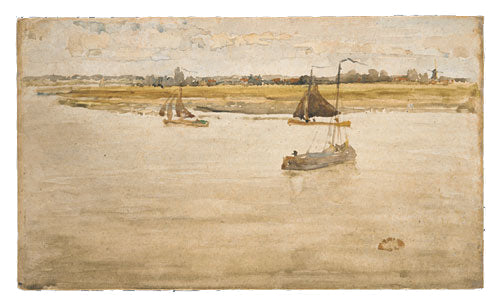Description
James McNeill Whistler, a painter who constantly challenged the conventions of his time, presents us in "gold and brown: Dordrecht - 1884" a work that, although apparently simple, encapsulates the essence of its aesthetic approach and its deep connection with the notion of Painting as an absent art of complex narratives. This work, part of its "nightly" series, highlights Whistler's mastery in color management and its ability to transform an ordinary scene into an emotional and sensory experience for the spectator.
"Gold and brown: Dordrecht" is a palpable sample of the evocative power of colors and the atmosphere. He painting It is dominated by shades of brown, amber and gold, which merge almost ethereal, creating an enveloping and almost mystical atmosphere. The choice of these colors is not accidental: Whistler seeks to capture the light of sunset or dawn, that intermediate moment of the day that bathes everything with a light of light that travels between clarity and darkness.
The composition of the work is remarkably balanced. In the center of the painting, you can see the silhouette of the city of Dordrecht, with its buildings and structures barely outlined. This reflects a technique that Whistler frequently adopted: the use of the suggestion on detailed representation. In this painting, architectural details are not their goal; Rather, it is the atmosphere and feeling that prevail. The horizon line is blurred on a misty horizon, mixing with the golden sky and reinforcing that feeling of an emerging world of dream.
The subtle reflexes in the water add another layer of texture and depth to the work, remembering the observer the serenity and mystery that can be found in a seemingly simple landscape. The surface of the water acts as a mirror, reflecting the lights and shadows with a lightness that gives the scene a soft and persuasive dynamism.
It is also important to talk about the context in which Whistler created this work. Known for his inclination towards aestheticism, Whistler defended the belief that art should be appreciated for its intrinsic beauty and not for its ability to communicate explicit narratives or moral messages. This aesthetic creed is palpable in "Gold and Brown: Dordrecht", where what prevails is not a concrete story but a sensation, an impression. Whistler is inspired by elements of the philosophy of "Art for Art s Sake" (art for art), showing how mere nuances and forms can transport the viewer to a state of reverent and sincere contemplation.
The technique with which Whistler addresses this work also suggests an influence of Japanese art, particularly in the application of flat colors and the use of asymmetric compositions. This influence, which Whistler huggedly throughout his career, provides "gold and brown: Dordrecht" a feeling of balance and serenity that is the very essence of its visual and emotional attraction.
In "Gold and Brown: Dordrecht - 1884", James McNeill Whistler invites us to experience the stillness and softness of a time suspended over time. Through its masterful use of color and its approach to a more abstract representation, Whistler transforms a scene inspired by the Dutch city into a visual meditation on light, atmosphere and pure beauty. This work, although simple at first glance, is a deep testimony of the transforming capacity of art, reminding us that sometimes, true beauty lies in what is not said, in what is suggested and in what it feels.
KUADROS ©, a famous paint on your wall.
Hand-made oil painting reproductions, with the quality of professional artists and the distinctive seal of KUADROS ©.
Art reproduction service with satisfaction guarantee. If you are not completely satisfied with the replica of your painting, we refund your money 100%.

